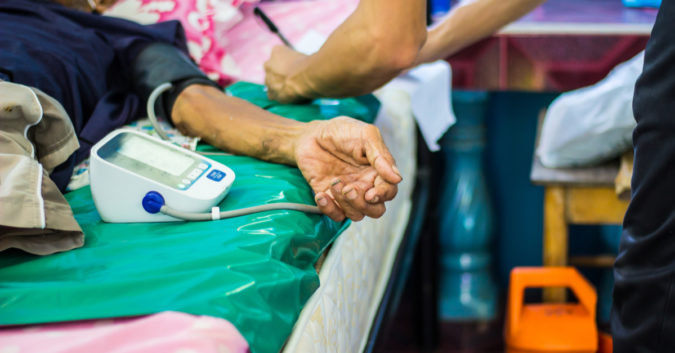The details of the novel coronavirus are still not fully understood, but that hasn’t stopped the virus from spreading at a rate that far exceeds our collective capacity to prevent it.
What is clear: The new coronavirus is now a pandemic, and it is especially threatening to the elderly and individuals with compromised immune systems.
According to data from the World Health Organization (WHO), people over the age of 60 are far more likely to develop a severe case of COVID-19 — the disease caused by the coronavirus. For those over 80, the death rate may be as high as 15%. (The overall death rate for coronavirus now stands at 3.4%, compared to 0.1% for seasonal flu.)
These harrowing figures have shown themselves in the number of nursing homes unlucky enough to have been impacted by the virus.
Nursing Homes in the Wake of the Coronavirus
In Washington state, thus far an epicenter for the nationwide outbreak, 5 long-term care facilities were infected with the virus, and officials believe more may be to come. In one home in the city of Kirkland, as many as 23 residents have died.
But it’s not just the infected facilities that have been impacted. Earlier this week, industry leaders recommended locking down elderly care facilities across the country and closing them off to all but essential visitors.
Florida Gov. Ron DeSantis on Wednesday imposed restrictions on who can visit nursing homes in the state. The governors of Ohio, Washington, and Illinois have enacted similar measures for facilities in their states.
Such moves may be necessary to protect patients, but they are also likely to exacerbate problems that already plague the nursing home community — namely, loneliness, boredom, and despair. Melissa West, a family member of an elderly care patient in Seattle, perhaps put it best in her interview with The New York Times:
“I’m concerned that the loneliness and helplessness will kill [her mother-in-law] quicker than the virus. I just think of her being there by herself. Just sitting in her wheelchair all day. Being trapped and waiting.”
What Can We Do?
So, what can patients and family members do for their loved ones in nursing homes?
Social Distancing: Increasingly, governments and health officials are advocating social distancing — the practice of avoiding crowds or gatherings and maintaining distances of 6 feet between individuals. Such practices were shown to be effective during the 1918 Spanish flu pandemic, which had similar mortality and contagion levels as the coronavirus.
But a nursing home is, almost by definition, a place of gathering. They require staff and medical personnel to mingle among patients, who themselves live among other patients. That means staff and patients will be fighting an uphill battle.
Remote Visiting: In addition to keeping visitors to an absolute minimum, nursing homes and industry leaders are encouraging remote visits. Through the use of FaceTime, Skype, Zoom, and other video chat platforms, patients can still enjoy the company of friends and family, albeit from a long distance.
Don’t Move Patients: The vast majority of experts advise against moving family members home or to another facility. The risk is simply too high, especially considering the variables and uncertainties that still shadow this outbreak.
Elderly patients are in nursing homes because they require personal, on-hand care, and that likely cannot be provided if they are moved to a loved one’s home. This advice has been echoed by both the Centers for Disease Control and Prevention (CDC) and the American Association of Retired Persons (AARP).
Sanitize Everything: Sanitization is, of course, very important. While medical facilities have their protocols for sanitizing and disinfecting equipment as well as personnel, such measures are likely to be tightened during an outbreak. That means not sharing medical equipment, accessories, stationery, pens, attire, cutlery, gadgets, or personal belongings — not merely between patients but between staff as well.
The CDC also recommends placing hand sanitizer in every resident room and stocking all sinks with an adequate supply of soap and paper towels. Staff should be designated to keep up on supplies of sanitation equipment, as well as tissues, face masks, gloves, gowns, and respirators.
Nursing Home Compare: The government also maintains a website for evaluating the quality and care of nursing homes around the country with a 5-star rating system. You can visit that website for a site-specific review of a nursing home’s record on sanitation and infection control, as well as overall patient experience.
Advice For Everyone
Despite the considerable alarm that has risen with the spread of the coronavirus, most experts say we are still within the early stages of a pandemic. Many more people will be infected in the coming weeks, and it’s anyone’s guess how events will unfold.
Supplies of much-needed equipment and materials may be in short supply, especially as cases ramp up. This only underscores the importance of taking voluntary steps to limit exposure.
The AARP and health officials recommend the following protocols be adopted in all nursing homes:
- Use gowns, gloves, face masks, and goggles when treating patients.
- Place residents suspected of having the virus in single rooms with closed doors.
- Close dining rooms and common areas and deliver meals to patients’ rooms.
To further protect those most vulnerable to the illness, individuals facing a relatively low risk of illness — young and healthy people — can follow the general advice laid out by health officials.
That means frequently washing your hands for at least 20 seconds at any given time, avoiding touching your face, avoiding contact with individuals known to have or suspected of having contracted the virus, staying home as much as possible, especially if sick, and cleaning and fully disinfecting surfaces, doorknobs, TV remotes, and other shared items.
It’s also important not to fall victim to the poles of outright panic and calm complacency. The ideal attitude is somewhere in the middle — cognizant of the dangers without letting fear take hold.
